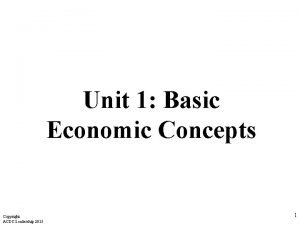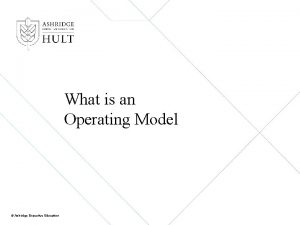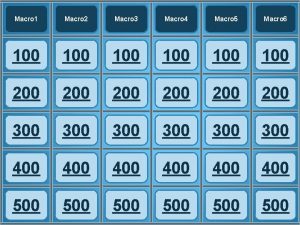Course Title Macro Economic Course Instructure Dr R












- Slides: 12

Course Title Macro Economic Course Instructure: Dr. R. K. Kumbhar Kaldor's Growth Model Nicholas Kaldor published an article in the ‘Economic Journal’ in 1957 titled as A Model of Economic Growth, which postulates a growth model that treat technology and technological progress as an endogenous unlike the other neo classical growth economists treat technology as exogenous variables. Kaldor’s model by following to both the Harrodian dynamic approach and the Keynesian techniques of analysis attempted "to provide a framework for relating the genesis of technical progress to capital accumulation", whereas HDM, Solow and the other neoclassical models treat the causation of technical progress as completely exogenous. Kaldor tried to understand why some societies grow so much faster than others? And according him it is not only the economic variables but the interaction of the non-economic variables determine the rate at which the general level of production of an economy is growing.

Assumptions of Kaldor Growth Model (1) In a growing economy the general level of output at any one time is limited by available resources, and not by effective demand. The model in other words assumes " full employment " in the strictly Keynesian sense-a state of affairs in which the short-period supply of goods and services in the aggregate is inelastic and irresponsive to further increases in monetary demand. (2) Y = W + P Income consists ofwages and profits where wages comprise salaries and earningsof manual labour and profit conlprise incomes of entrepreneurs as well as propertyowners. (3) S = Sp + Sw Total savings consists of savings out of wages wd savings out ofprofits. (4) Profits in the economy are a function of investment (5) Prices are assumed to be constant i. e. monetary policy has a very little role to play

Assumptions of Kaldor Growth Model (6) The choice oftechniques is also assumed to alter with the accumulation of capital and the progress of technique is the capital-grade making industries. (7) Technical progress depends on the rate of capital accumulation. WORKING OF THE MODEL Kaldor's model can works under two stages a. constant working population b. expanding population In the former case (constant full employment being assumed) the proportionate rate of growth in total real income, Yr, will be the same as the proportionate rate of growth in output per head, O, In the latter case the proportionate change in total real income will be the sum of the proportionate change in productivity, Ot, and the proportionate change in the working population Lt.

eal Constant Working Population(CWP) Kaldor postulate three functions for the working of the model (i) Given savings propensities for profit-earners and wage-earners. (ii) the investment decisions in any one period are governed by the desire to maintain the capital stock in a given relationship to turnover, modified by any change in the rate of profit on capital; (iii) a given technical relationship between the (proportionate) rate of growth in productivity per man and the (proportionate) rate of growth in capital per man. Writing for investment at the time t, we may assume the familiar income identities

WORKING OF KALDOR'S GROWTH MODEL WITH CWP (1) Saving Function The function shows total savings as consisting of a proportion of total profits and a proportion of total wages.

Constant Working Population(CWP) (2) Investment function The investment function state that - Capital stock at time period 't' is equal to a constant fraction (alpha prime) of the output of the preceding period plus a constant proportion (beta prime) of the rate of profit of previous period, multiplied by the output of the preceding period. it also depicts invest demand functions.

Constant Working Population(CWP) (3) Technical Progress Function The function shows the rate of growth of income (and labour productivity) as an increasing function of the rate of net investment expressed as a proportion of the stock of capital.

Constant Working Population(CWP) All the functions taken together depicts the mechanism underlying savings and investment- Ø the savings function indicates that savings are determined by the propensity to save out of profits and wages respectively. Ø The investment function shows that investment is determined by the rate of profit and the changes associated with it. Ø The technical progress function shows that the rate of growth of income is a function of the rate of investment, capital person and the technical progress.

Analysis of the Kaldor's growth model with Constant Working Population(CWP) Given the above functions, taking an arbitrary point of time, say t = 1, the existing stock of capital K 1 can be considered as a datum which is inherited from the past. Y 1 can be taken as given which the fully employed labour force produces with the capital stock K 1. Similarly, the income and capital in the previous period Y 0, and K 0 respectively are given. Capital stock K 1 satisfies the following condition.

Analysis of the Kaldor's growth model with Constant Working Population(CWP) The above equation shows that the rate of investment in period 1, as proportion of income of that period equals the rate of growth of income over the previous period multiplied by the capital-output ratio of the current period, plus a proportion of the change of the rate of profit over the previous period. This may be written as follow

Analysis of the Kaldor's growth model with Constant Working Population(CWP) Last two equations jointly determine both the distribution of income between profits and wages, and the proportion of income saved and invested at t=1. Given a particular income distribution, the level of profits acts as the equilibrating mechanism between savings and investment. The level of profits has to be such as to induce a rate of investment that is just equal to the rate of savings at that particular distribution of income.

Question and References • How Kaldor's economic growth model is different from other neoclassical growth models? Derived the Kaldor's economic growth model with constant working Population. • References • • Nicholas Kaldor: A Model of Economic Growth, Economic Journal, 1957 egyankosh and pathsala materials
 Course title and course number
Course title and course number Happy
Happy Explain conditional macro expansion with example
Explain conditional macro expansion with example Acdc leadership
Acdc leadership Difference between economic growth and economic development
Difference between economic growth and economic development Lesson 2 our economic choices
Lesson 2 our economic choices Economic growth vs economic development
Economic growth vs economic development Title title
Title title Title fly of a report
Title fly of a report Web services mgccc
Web services mgccc Polism model
Polism model Fhict.instructure
Fhict.instructure Verdanak part 2
Verdanak part 2























